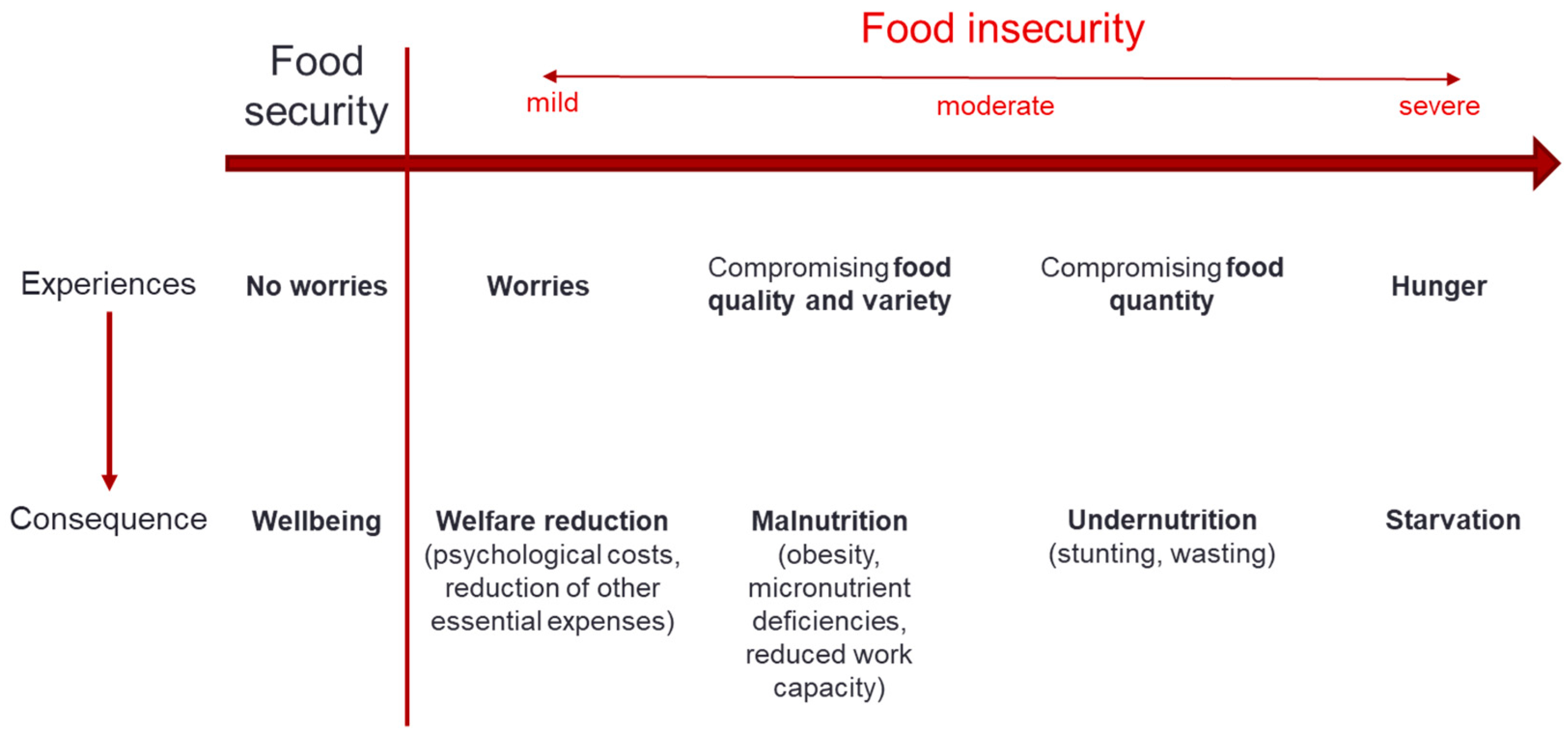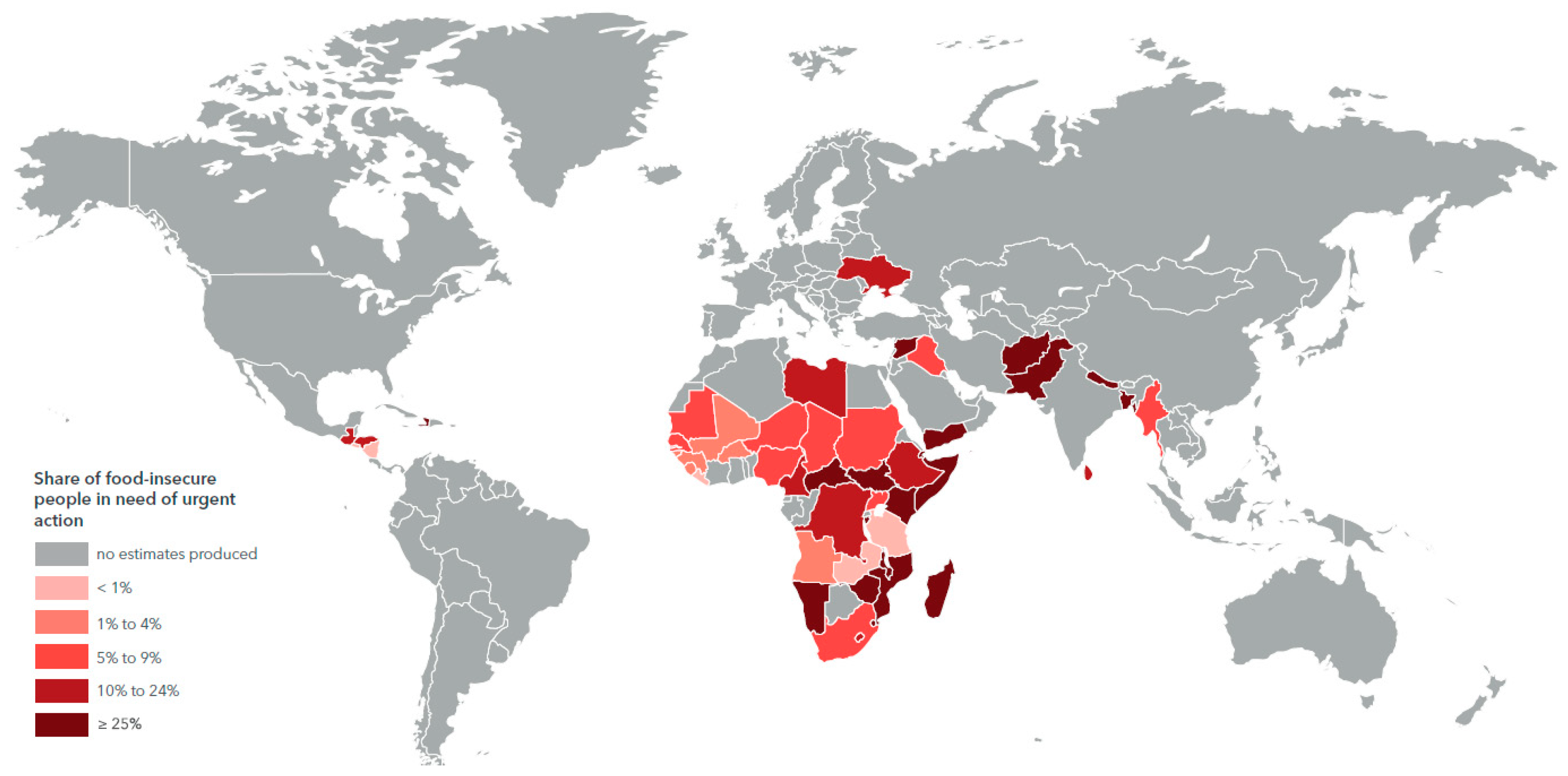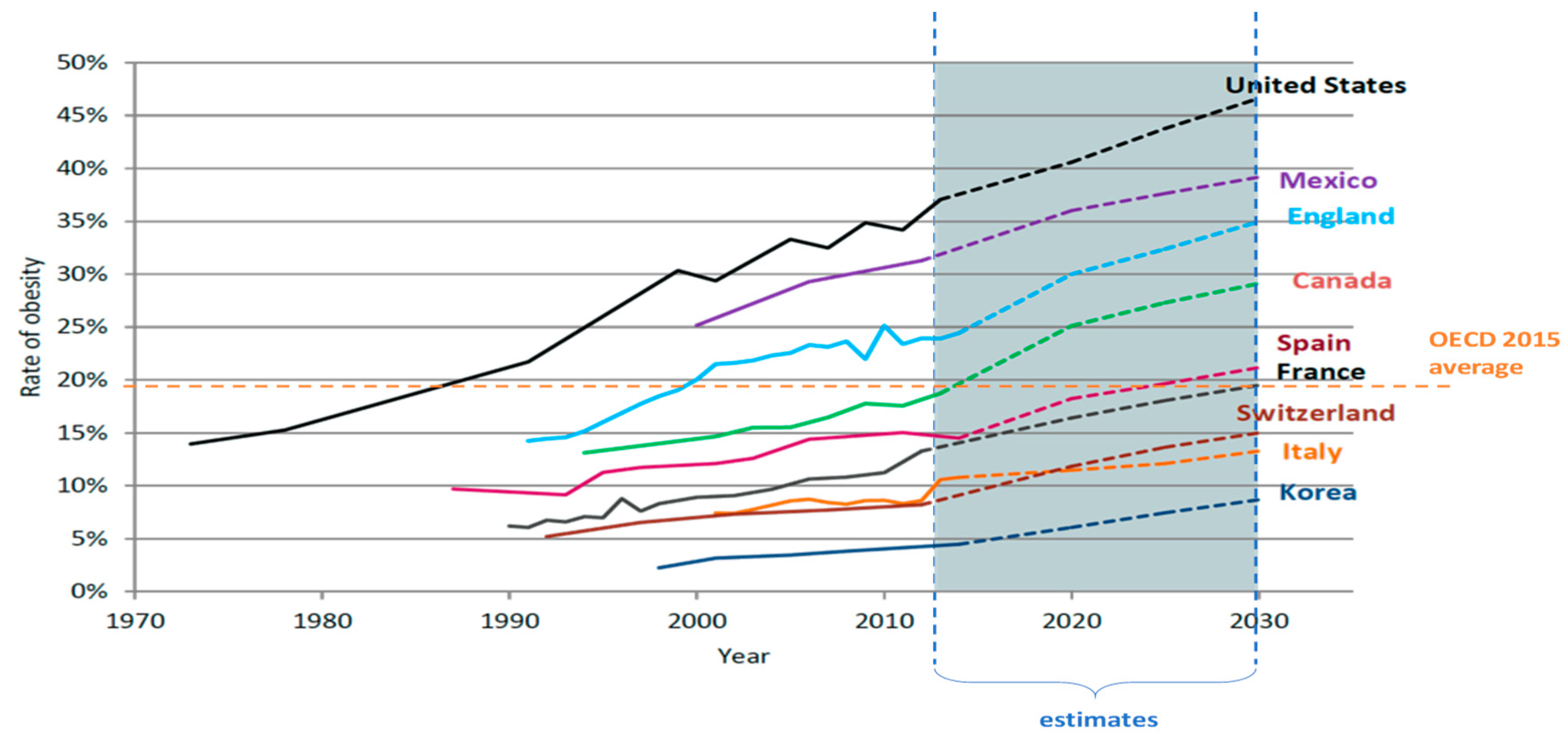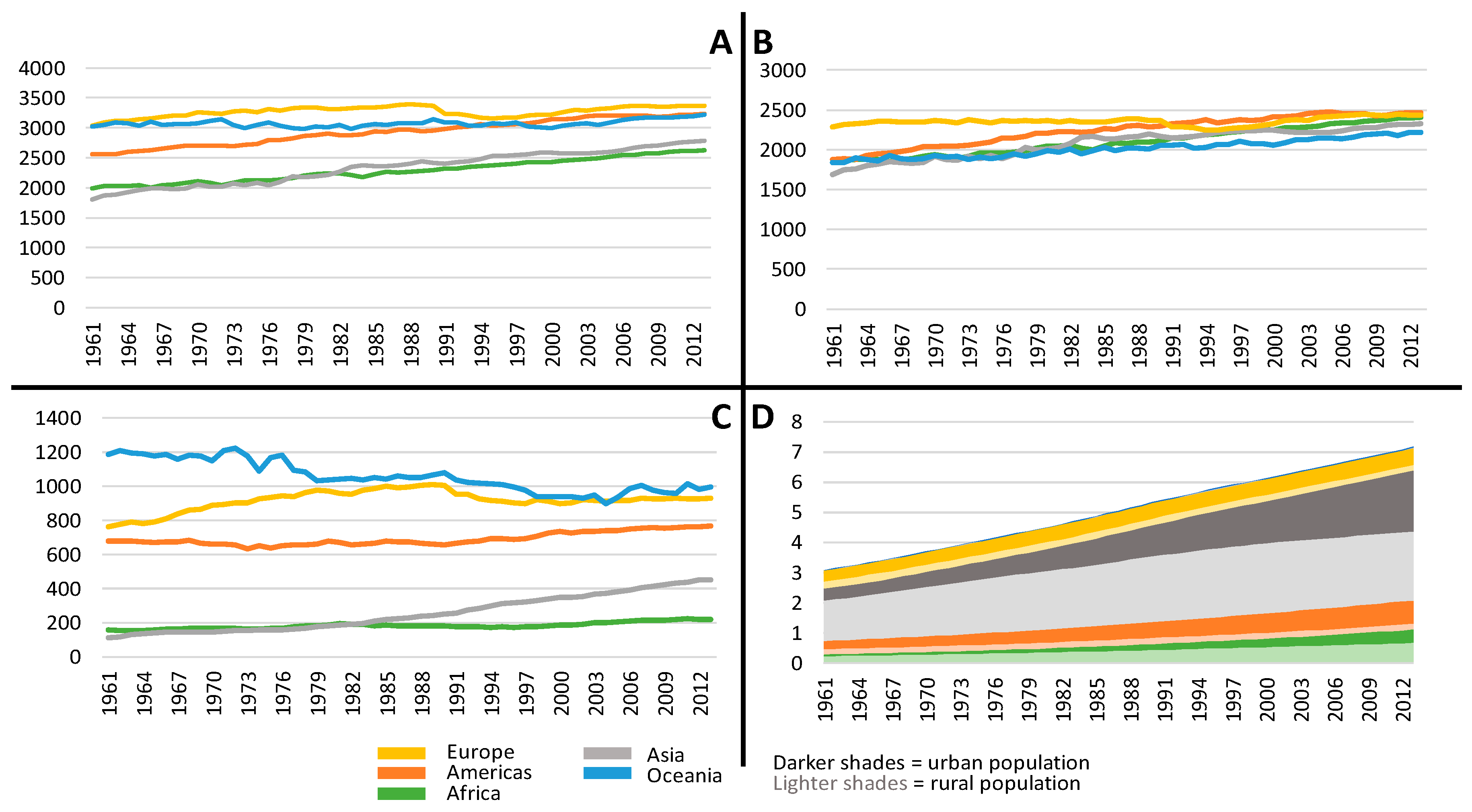Hunger and Obesity as Symptoms of Non-Sustainable Food Systems and Malnutrition
Abstract
:1. Sustainable Food Systems
2. The Global Phenomenon of Hunger and Malnutrition
3. The Obesity Epidemic and the Hunger-Obesity Paradox
4. Development of Global Food Supply over the Past Five Decades
5. Food Security in the Face of Increasing Food Demands
6. Strategies & Policies towards a Sustainable Food System & Responsibilities
- (1)
- measures for an increase in food production, either by boosting crop yields of today’s agricultural land by more sophisticated seeds (e.g., hybrid seeds), improved fertilization (and application of 4Rs [84]) and irrigation systems (e.g., the use of cheaper drip-irrigation systems for smallholder farmers [56]), in general, efficiency improvements along the entire foods values chain including better logistics and storage systems (to avoid food losses during production, storage and transport; for example, vertical farming), and/or, by clearing further land for agriculture under the consideration of the land resource–food price nexus [29] or, more generally, by adopting new land-use scenarios under consideration of given path dependencies; all of which geared towards closing yield gaps (the difference between observed versus regional attainable yield) through nutrient and water management;
- (2)
- food losses and waste prevention, alternative uses and recycling;
- (3)
- avoidance of food overconsumption and changed quality related consumption patterns, including increases in organic food production;
- (4)
- hybrid solutions of (1), (2), and/or (3) (as core element of comprehensive system interventions);
- (5)
- the development of health programs, which build on joint (pro)active and passive health-related nutrition initiatives and a higher awareness regarding own food consumption patterns as well as their consequences including behavioural change (nudging); and
- (6)
- the establishment of food and health policies including taxation and appropriate educational measures, which build on the increased responsibility of all members of society.
7. Conclusions and Future Implications
Author Contributions
Funding
Acknowledgments
Conflicts of Interest
References
- Black, R.E.; Allen, L.H.; Bhutta, Z.A.; Caulfield, L.E.; de Onis, M.; Ezzati, M.; Mathers, C.; Rivera, J.; Maternal and Group Child Undernutrition Study. Maternal and Child Undernutrition: Global and Regional Exposures and Health Consequences. Lancet 2008, 371, 243–260. [Google Scholar] [CrossRef]
- Shafique, S.; Akhter, N.; Stallkamp, G.; de Pee, S.; Panagides, D.; Bloem, M.W. Trends of under- and Overweight among Rural and Urban Poor Women Indicate the Double Burden of Malnutrition in Bangladesh. Int. J. Epidemiol. 2007, 36, 449–457. [Google Scholar] [CrossRef] [PubMed]
- Zhai, L.; Dong, Y.; Bai, Y.; Wei, W.; Jia, L. Trends in Obesity, Overweight, and Malnutrition among Children and Adolescents in Shenyang, China in 2010 and 2014: A Multiple Cross-Sectional Study. BMC Public Health 2017, 17, 151. [Google Scholar] [CrossRef] [PubMed]
- Doku, D.T.; Neupane, S. Double Burden of Malnutrition: Increasing Overweight and Obesity and Stall Underweight Trends among Ghanaian Women. BMC Public Health 2015, 15, 670. [Google Scholar] [CrossRef] [PubMed]
- Food and Agriculture Organization of the United Nations. Addressing Food Insecurity in Protracted Crises. In The State of Food Insecurity in the World; FAO: Rome, Italy, 2013. [Google Scholar]
- James, W.P.T. From Treating Childhood Malnutrition to Public Health Nutrition. Ann. Nutr. Metab. 2018, 72, 202–209. [Google Scholar] [CrossRef] [PubMed]
- Brundtland, G.H. Nutrition and Infection: Malnutrition and Mortality in Public Health. Nutr. Rev. 2000, 58 Pt 2, S1–S4, discussion S63–S73. [Google Scholar] [CrossRef]
- De Onis, M.; Monteiro, C.; Akre, J.; Glugston, G. The Worldwide Magnitude of Protein-Energy Malnutrition: An Overview from the Who Global Database on Child Growth. Bull. World Health Organ. 1993, 71, 703–712. [Google Scholar]
- Vesel, L.; Bahl, R.; Martines, J.; Penny, M.; Bhandari, N.; Kirkwood, B.R.; the WHO Immunization-linked Vitamin A Supplementation Study Group. Use of New World Health Organization Child Growth Standards to Assess How Infant Malnutrition Relates to Breastfeeding and Mortality. Bull. World Health Organ. 2010, 88, 39–48. [Google Scholar] [CrossRef]
- Gaggero, C. Children: Reducing Mortality; World Health Organization (WHO): Geneva, Switzerland, 2018. [Google Scholar]
- Wang, X.; Hojer, B.; Guo, S.; Luo, S.; Zhou, W.; Wang, Y. Stunting and ‘Overweight’ in the Who Child Growth Standards—Malnutrition among Children in a Poor Area of China. Public Health Nutr. 2009, 12, 1991–1998. [Google Scholar] [CrossRef]
- Food and Agriculture Organization of the United Nations. Food Security. Policy Brief. In Food Security; FAO: Rome, Italy, 2006. [Google Scholar]
- American Public Health Association. Toward a Healthy Sustainable Food System. 2007. Available online: https://www.apha.org/policies-and-advocacy/public-health-policy-statements/policy-database/2014/07/29/12/34/toward-a-healthy-sustainable-food-system (accessed on 3 September 2018).
- Laws, D.; Scholz, R.W.; Shiroyama, H.; Susskind, L.; Suzuki, T.; Weber, O. Expert Views on Sustainability and Technology Implementation. Int. J. Sustain. Dev. World Ecol. 2004, 11, 247–261. [Google Scholar] [CrossRef]
- Vieira, L.C.; Serrao-Neumann, S.; Howes, M.; Mackey, B. Unpacking Components of Sustainable and Resilient Urban Food Systems. J. Clean. Prod. 2018, 200, 318–330. [Google Scholar] [CrossRef]
- Feenstra, G. Creating Space for Sustainable Food Systems: Lessons from the Field. Agric. Hum. Values 2002, 19, 99–106. [Google Scholar] [CrossRef]
- Scholz, R.W.; Steiner, G. The Real Type and Ideal Type of Transdisciplinary Processes: Part I—Theoretical Foundations. Sustain. Sci. 2015, 10, 527–544. [Google Scholar] [CrossRef]
- Steiner, G. Supporting Sustainable Innovation through Stakeholder Management: A Systems View. Int. J. Inno Learn. 2008, 5, 595–616. [Google Scholar] [CrossRef]
- Pichs-Madruga, R.; Obersteiner, M.; Cantele, M.; Ahmed, M.T.; Cui, X.; Cury, P.; Fall, S.; Kellner, K. Building Scenarios and Models of Drivers of Biodiversity and Ecosystem Change; Ferrier, S., Ninan, K.N., Leadley, P., Alkemade, R., Acosta, L.A., Akçakaya, H.R., Brotons, L., Cheung, W.W.L., Christensen, V., Harhash, K.A., Eds.; Methodological Assessment of Scenarios and Models of Biodiversity and Ecosystem Services; Secretariat of the Intergovernmental Platform for Biodiversity and Ecosystem Services: Bonn, Germany, 2016. [Google Scholar]
- Leclere, D.; Obersteiner, M.; Alkemade, R.; Almond, R.; Barrett, M.; Bunting, G.; Burgess, N.; Butchart, S. Towards Pathways Bending the Curve Terrestrial Biodiversity Trends within the 21st Century; IIAS: Laxenburg, Austria, 2018. [Google Scholar]
- Balkovic, J.; Skalsky, R.; Folberth, C.; Khabarov, N.; Schmidt, E.; Madaras, M.; Obersteiner, M.; van der Velde, M. Impacts and Uncertainties of +2 °C of Climate Change and Soil Degradation on European Crop Calorie Supply. Earth’s Future 2018, 6, 373–395. [Google Scholar] [CrossRef] [PubMed]
- Barilla Center for Food and Nutrition. Double Pyramid 2016; Barilla Center for Food and Nutrition: Parma, Italy, 2017. [Google Scholar]
- Geissler, B.; Mew, M.C.; Weber, O.; Steiner, G. Efficiency Performance of the World’s Leading Corporations in Phosphate Rock Mining. Resour. Conserv. Recycl. 2015, 105, 246–258. [Google Scholar] [CrossRef]
- Wellmer, F.W.; Scholz, R.W. The Right to Know the Geopotential of Minerals for Ensuring Food Supply Security. J. Ind. Ecol. 2015, 19, 3–6. [Google Scholar] [CrossRef]
- De Ridder, M.; de Jong, S.; Polchar, J.; Lingemann, S. Risks and Opportunities in the Global Phosphate Rock Market—Robust Strategies in Times of Uncertainty; The Hague Centre for Strategic Studies: Den Haag, The Netherlands, 2012. [Google Scholar]
- World Bank. Migration and Mobility. Europe and Central Asia Economic Update; World Bank Group: Washington, DC, USA, 2017. [Google Scholar]
- United Nations. Mobility and Migration. A Guidance Note for Human Development Report Teams; United Nations Development Programme (UNDP): New York, NY, USA, 2010. [Google Scholar]
- Steiner, G. Agriculture-Dominated Societies, Climate Change and Migration: A Case for Transdisciplinarity. In Migration and Globalisierung in Zeiten Des Umbruchs; Altenberug, F., Faustmann, A., Pfeffer, T., Skrivanek, I., Eds.; Edition Donau-Universität Krems: Krems, Austria, 2017; pp. 411–416. [Google Scholar]
- Obersteiner, M.; Walsh, B.; Frank, S.; Havlik, P.; Cantele, M.; Liu, J.; Palazzo, A.; Herrero, M.; Lu, Y.; Mosnier, A.; et al. Assessing the Land Resource-Food Price Nexus of the Sustainable Development Goals. Sci. Adv. 2016, 2, e1501499. [Google Scholar] [CrossRef]
- NATO. Resilience and Risk. Methods and Application in Environment, Cyber and Social Domains. In NATO Science for Peace and Security Series—C: Environmental Security; Linkov, I., Palma-Oliveira, J.M., Eds.; NATO: Amsterdam, The Netherlands, 2017. [Google Scholar]
- Scholz, R.W.; Steiner, G.; Parycek, P. Sustainability and Digital Environment; Sustainable Engineering and Science; MDPI: Basel, Switzerland, 2018. [Google Scholar]
- United Nations. Transforming Our World: The 2030 Agenda for Sustainable Development; UNDP: New York, NY, USA, 2015. [Google Scholar]
- Steiner, G.; Geissler, B.; Schreder, G.; Zenk, L. Living Sustainability, or Merely Pretending? From Explicit Self-Report Measures to Implicit Cognition. Sustain. Sci. 2018, 13, 1001–1015. [Google Scholar] [CrossRef]
- Finkelstein, E.A.; Ruhm, C.J.; Kosa, K.M. Economic Causes and Consequences of Obesity. Annu. Rev. Public Health 2005, 26, 239–257. [Google Scholar] [CrossRef]
- HLPE. Nutrition and Food Systems. A Report by the High Level Panel of Experts on Food Security and Nutrition of the Committee on World Food Securit; HLPE: Rome, Italy, 2017. [Google Scholar]
- Westhoek, H.; Ingram, J.; Van Berkum, S.; Özay, L.; Hajer, M. Food Systems and Natural Resources. A Report of the Working Group on Food Systems of the International Resource Panel; UNEP: Nairobi, Kenya, 2016. [Google Scholar]
- West, P.C.; Gerber, J.S.; Engstrom, P.M.; Mueller, N.D.; Brauman, K.A.; Carlson, K.M.; Cassidy, E.S.; Johnston, M.; MacDonald, G.K.; Ray, D.K.; et al. Leverage Points for Improving Global Food Security and the Environment. Science 2014, 345, 325–328. [Google Scholar] [CrossRef] [PubMed]
- World Food Summit. Rome Declaration on World Food Security and World Food Summit Plan of Action. United Nations, 1996. Available online: http://www.fao.org/DOCREP/003/W3613E/W3613E00.HTM (accessed on 17 December 2018).
- Smith, K.B.; Smith, M.S. Obesity Statistics. Prim. Care 2016, 43, 121–135. [Google Scholar] [CrossRef] [PubMed]
- Egger, G.; Dixon, J. Beyond Obesity and Lifestyle: A Review of 21st Century Chronic Disease Determinants. BioMed Res. Int. 2014, 2014, 731685. [Google Scholar] [CrossRef] [PubMed]
- United Nations Office of the High Commissioner Human Rights (UN-OHCHR). Special Rapporteur on the Right to Food. United Nations, 2008. Available online: http://www.ohchr.org/EN/issues/food/Pages/FoodIndex.aspx (accessed on 18 December 2018).
- Kullander, S. One Billion People Are Chronically Undernourished. Ambio 2010, 39, preceding-A6. [Google Scholar]
- FAO; IFAD; UNICEF; WFP; WHO. The State of Food Security and Nutrition in the World 2017. Building Resilience for Peace and Food Security. In The State of Food Security and Nutrition in the World; FAO: Rome, Italy, 2017. [Google Scholar]
- Misselbrook, D. W Is for Wellbeing and the Who Definition of Health. Br. J. Gen. Pract. 2014, 64, 582. [Google Scholar] [CrossRef]
- Costanza, R.; Hart, M.; Posner, S.; Talberth, J.Y. Beyond Gdp: The Need for New Measures of Progress; The Pardee Papers No. 4; Boston University: Boston, MA, USA, 2009. [Google Scholar]
- Lozano, R.; Naghavi, M.; Foreman, K.; Lim, S.; Shibuya, K.; Aboyans, V.; Abraham, J.; Adair, T.; Aggarwal, R.; Ahn, S.Y.; et al. Global and Regional Mortality from 235 Causes of Death for 20 Age Groups in 1990 and 2010: A Systematic Analysis for the Global Burden of Disease Study 2010. Lancet 2012, 380, 2095–2128. [Google Scholar] [CrossRef]
- Sabates-Wheeler, R.; Devereux, S. Social Protection and the World Food Programme; Occasional Paper Nr. 25; World Food Programme (WFP): Rome, Italy, 2018. [Google Scholar]
- Lever, A.F.; Hole, D.J.; Gillis, C.R.; McCallum, I.R.; McInnes, G.T.; MacKinnon, P.L.; Meredith, P.A.; Murray, L.S.; Reid, J.L.; Robertson, J.W. Do Inhibitors of Angiotensin-I-Converting Enzyme Protect against Risk of Cancer? Lancet 1998, 352, 179–184. [Google Scholar] [CrossRef]
- Food Security Information Network (FSIN). Global Report on Food Crises; FSIN: 6716 AE Ede, The Netherlands, 2018. [Google Scholar]
- Integrated Food Security Phase Classification (IPC). Evidence and Standards for Better Food Security Decisions. IPC Technical Manual Version 2.0; The IPC Global Partners; FAO: Rome, Italy, 2012.
- OECD. Obesity Update 2017; Better Policies for Better Lives; OECD: Paris, France, 2017. [Google Scholar]
- Westall, S. Wfp Forced to Cut Food Aid for Syrian Refugees by Half. Reuters World News, 1 August 2015. [Google Scholar]
- Swinburn, B.A.; Sacks, G.; Hall, K.D.; McPherson, K.; Finegood, D.T.; Moodie, M.L.; Gortmaker, S.L. The Global Obesity Pandemic: Shaped by Global Drivers and Local Environments. Lancet 2011, 378, 804–814. [Google Scholar] [CrossRef]
- Ng, M.; Fleming, T.; Robinson, M.; Thomson, B.; Graetz, N.; Margono, C.; Mullany, E.C.; Biryukov, S.; Abbafati, C.; Abera, S.F.; et al. Global, Regional, and National Prevalence of Overweight and Obesity in Children and Adults During 1980–2013: A Systematic Analysis for the Global Burden of Disease Study 2013. Lancet 2014, 384, 766–781. [Google Scholar] [CrossRef]
- Goel, M.S.; McCarthy, E.P.; Phillips, R.S.; Wee, C.C. Obesity among Us Immigrant Subgroups by Duration of Residence. JAMA 2004, 292, 2860–2867. [Google Scholar] [CrossRef] [PubMed]
- Paarlberg, R. The United States of Excess: Gluttony and the Dark Side of American Exceptionalism; Oxford University Press: Oxford, UK, 2015. [Google Scholar]
- Christeson, W.; Dawson Taggart, A.; Messner-Zidell, S. Too Fat to Fight: Retired Military Leaders Want Junk Food Out of America’s Schools; Mission: Readiness—Military Leaders for Kids; Readiness: Washigton, DC, USA, 2010. [Google Scholar]
- Abdelaal, M.; le Roux, C.W.; Docherty, N.G. Morbidity and Mortality Associated with Obesity. Ann. Transl. Med. 2017, 5, 161. [Google Scholar] [CrossRef] [PubMed]
- Cleland, V.; McNeilly, B.; Crawford, D.; Ball, K. Obesity Prevention Programs and Policies: Practitioner and Policy-Maker Perceptions of Feasibility and Effectiveness. Obesity 2013, 21, E448–E455. [Google Scholar] [CrossRef] [PubMed]
- Eisenberg, M.J.; Atallah, R.; Grandi, S.M.; Windle, S.B.; Berry, E.M. Legislative Approaches to Tackling the Obesity Epidemic. CMAJ 2011, 183, 1496–1500. [Google Scholar] [CrossRef] [PubMed]
- Robert Wood Johnson Foundation. Decliing Childhood Obesity Rates: Where Are We Seeing Signs of Progress? Health Policy Snapshot Series; Robert Wood Johnson Foundation: Princeton, NJ, USA, 2016. [Google Scholar]
- European Commission. Food and Non-Alcoholic Beverage Marketing to Children and Adolescents. European Commission. Available online: https://ec.europa.eu/jrc/en/health-knowledge-gateway/promotion-prevention/other-policies/marketing#_Toc488056622 (accessed on 17 December 2018).
- Mozaffarian, D.; Hao, T.; Rimm, E.B.; Willett, W.C.; Hu, F.B. Changes in Diet and Lifestyle and Long-Term Weight Gain in Women and Men. N. Engl. J. Med. 2011, 364, 2392–2404. [Google Scholar] [CrossRef] [PubMed]
- Corsi, D.J.; Finlay, J.E.; Subramanian, S.V. Global Burden of Double Malnutrition: Has Anyone Seen It? PLoS ONE 2011, 6, e25120. [Google Scholar] [CrossRef]
- Godfray, H.C.J.; Aveyard, P.; Garnett, T.; Hall, J.W.; Key, T.J.; Lorimer, J.; Pierrehumbert, R.T.; Scarborough, P.; Springmann, M.; Jebb, S.A. Meat Consumption, Health, and the Environment. Science 2018, 361. [Google Scholar] [CrossRef]
- Behrens, P.; Kiefte-de Jong, J.C.; Bosker, T.; Rodrigues, J.F.D.; de Koning, A.; Tukker, A. Evaluating the Environmental Impacts of Dietary Recommendations. Proc. Natl. Acad. Sci. USA 2017, 114, 13412–13417. [Google Scholar] [CrossRef]
- Springmann, M.; Godfray, H.C.; Rayner, M.; Scarborough, P. Analysis and Valuation of the Health and Climate Change Cobenefits of Dietary Change. Proc. Natl. Acad. Sci. USA 2016, 113, 4146–4151. [Google Scholar] [CrossRef]
- Misra, A.; Khurana, L. Obesity and the Metabolic Syndrome in Developing Countries. J. Clin. Endocrinol. Metab. 2008, 93, S9–S30. [Google Scholar] [CrossRef]
- Popkin, B.M. Global Nutrition Dynamics: The World Is Shifting Rapidly toward a Diet Linked with Noncommunicable Diseases. Am. J. Clin. Nutr. 2006, 84, 289–298. [Google Scholar] [CrossRef]
- Béné, C.; Barange, M.; Subasinghe, R.; Pinstrup-Andersen, P.; Merino, M.; Hemre, G.-I.; Williams, M. Feeding 9 Billion by 2050—Putting Fish Back on the Menu. Food Secur. 2015, 7, 261–274. [Google Scholar] [CrossRef]
- Alexandratos, N.; Bruinsma, J. World Agriculture Towards 2030/2050. The 2012 Revision. FAO. Available online: http://www.fao.org/docrep/016/ap106e/ap106e.pdf (accessed on 17 December 2018).
- Ray, D.K.; Mueller, N.D.; West, P.C.; Foley, J.A. Yield Trends Are Insufficient to Double Global Crop Production by 2050. PLoS ONE 2013, 8, e66428. [Google Scholar] [CrossRef] [PubMed]
- Heffer, P.; Prud’homme, M. Fertilizer Outlook 2016–2020; International Fertilizer Industry Association: Paris, France, 2016. [Google Scholar]
- Clarke, R. Outlook ’14—Fertilizer Markets Eye Pick up in Demand for 2014. Independent Chemical Information Services (ICIS) News. 2013. Available online: http://www.icis.com/resources/news/2013/12/23/9737765/outlook-14-fertilizer-markets-eye-pick-up-in-demand-for-2014/ (accessed on 3 September 2018).
- IFDC/FAI. Fertilzier Subsidies—Which Way Forward? Huang, J., Gulati, A., Gregory, I., Eds.; IFDC/FAI: New Delhi, India, 2017. [Google Scholar]
- Weber, O.; Delince, J.; Duan, Y.; Maene, L.; McDaniels, T.; Mew, M.; Schneidewind, U.; Steiner, G. Trade and Finance as Cross-Cutting Issues in the Global Phosphate and Fertilizer Market. In Sustainable Phosphorus Management. A Global Transdisciplinary Roadmap; Scholz, R.W., Roy, A.H., Brand, F.S., Hellums, D.T., Ulrich, A.E., Eds.; Springer: New York, NY, USA, 2014. [Google Scholar]
- Hernandez, M.A.; Torero, M. Fertilizer Market Situation: Market Structure, Consumption and Trade Patterns, and Pricing Behavior. International Food Policy Research Institute (IFPRI). Available online: http://www.ifpri.org/sites/default/files/publications/ifpridp01058.pdf (accessed on 17 December 2018).
- Swedish Institute for Food and Biotechnology (SIK). Global Food Losses and Food Waste; International Congress SAVE FOOD! Interpack, Ed.; FAO: Rome, Italy, 2011. [Google Scholar]
- Parfitt, J.; Barthel, M.; Macnaughton, S. Food Waste within Food Supply Chains: Quantification and Potential for Change to 2050. Philos. Trans. R. Soc. B 2010, 365, 3065–3081. [Google Scholar] [CrossRef] [PubMed]
- Gore-Langton, L. France’s Food Waste Ban: One Year On. Available online: https://www.foodnavigator.com/Article/2017/03/24/France-s-food-waste-ban-One-year-on (accessed on 3 September 2018).
- Steiner, G.; Geissler, B. Sustainable Mineral Resource Management—Insights into the Case of Phosphorus. Sustainability 2018, 10, 2731. [Google Scholar] [CrossRef]
- Leischow, S.J.; Milstein, B. Systems Thinking and Modeling for Public Health Practice. Am. J. Public Health 2006, 96, 403–405. [Google Scholar] [CrossRef]
- Steiner, G. Unlock Hidden Innovation Potentials: Uncertainty, Risk, & Opportunity Costs. In Proceedings of the IFA Production & International Trade Conference, Paris, France, 22–24 February 2017. [Google Scholar]
- International Fertilizer Association. What Are the 4rs. Available online: https://www.nutrientstewardship.com/4rs/ (accessed on 3 September 2018).
- Steiner, G. From Probabilistic Functionalism to a Mental Simulation of Innovation: By Collaboration from Vulnerabilities to Resilient Societal Systems. Environ. Syst. Decis. 2018, 38, 92–98. [Google Scholar] [CrossRef]
- Prahalad, C.K.; Hammond, A. The Fortune at the Bottom of the Pyramide. Strategy Bus. 2002, 20, 1–13. [Google Scholar]
- Drew, J.; Joseph, J. The Story of the Fly and How It Could Save the World; Cheviot: Vlaeberg, South Africa, 2012. [Google Scholar]
- Doshi, V. Kolkata: The City That Eats Fish Reared on Sewage. The Guardian, 25 January 2017. [Google Scholar]




© 2019 by the authors. Licensee MDPI, Basel, Switzerland. This article is an open access article distributed under the terms and conditions of the Creative Commons Attribution (CC BY) license (http://creativecommons.org/licenses/by/4.0/).
Share and Cite
Steiner, G.; Geissler, B.; Schernhammer, E.S. Hunger and Obesity as Symptoms of Non-Sustainable Food Systems and Malnutrition. Appl. Sci. 2019, 9, 1062. https://doi.org/10.3390/app9061062
Steiner G, Geissler B, Schernhammer ES. Hunger and Obesity as Symptoms of Non-Sustainable Food Systems and Malnutrition. Applied Sciences. 2019; 9(6):1062. https://doi.org/10.3390/app9061062
Chicago/Turabian StyleSteiner, Gerald, Bernhard Geissler, and Eva S. Schernhammer. 2019. "Hunger and Obesity as Symptoms of Non-Sustainable Food Systems and Malnutrition" Applied Sciences 9, no. 6: 1062. https://doi.org/10.3390/app9061062
APA StyleSteiner, G., Geissler, B., & Schernhammer, E. S. (2019). Hunger and Obesity as Symptoms of Non-Sustainable Food Systems and Malnutrition. Applied Sciences, 9(6), 1062. https://doi.org/10.3390/app9061062





